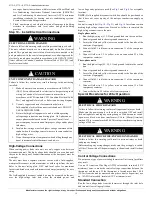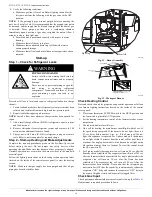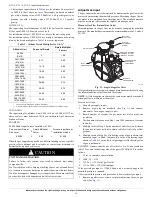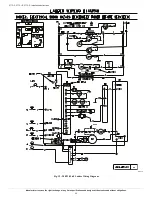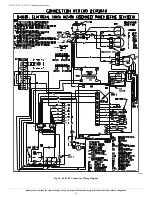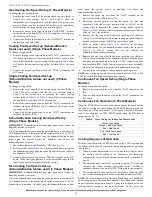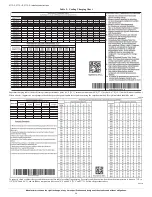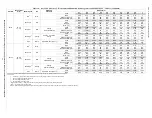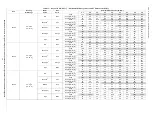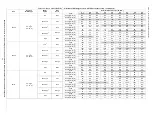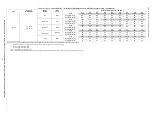
577C--C, 577C--E, 577C--F: Installation Instructions
Manufacturer reserves the right to change, at any time, specifications and designs without notice and without obligations.
25
Normal Operation
An LED (light-emitting diode) indicator is provided on the integrated
gas unit controller (IGC) to monitor operation. The IGC is located by
removing the control access panel (see
). During normal
operation, the LED is continuously on (See
for error codes).
Airflow and Temperature Rise
The heating section for each size unit is designed and approved for
heating operation within the temperature-rise range stamped on the unit
rating plate.
,
and
show the approved temperature rise
range for each heating input, and the air delivery CFM at various
temperature rises for a given external static pressure. The heating
operation airflow must produce a temperature rise that falls within the
approved range. For single phase units only, “High” blower speed is for
high static cooling only and must not be used for gas heating speed.
Refer to Indoor Airflow and Airflow Adjustments section to adjust
heating airflow when required.
Heating Sequence of Operation (Single Phase
Models)
On a call for heating, terminal W of the thermostat is energized, starting
the induced-draft motor for a 5 second pre-purge. When the pressure
switch senses that the induced-draft motor is moving sufficient
combustion air, the burner sequence begins. This function is controlled
by the integrated gas unit controller (IGC). The indoor (evaporator) –fan
motor is energized 30 seconds after flame is established. When the
thermostat is satisfied and W is de-energized, the burners stop firing and
the indoor (evaporator) fan motor shuts off after a 90 second time-off
delay. Please note that the IGC has the capability to automatically reduce
the indoor fan motor on delay and increase the indoor fan motor off
delay in the event of high duct static and/or a partially-clogged filter.
Heating Sequence of Operation (3 Phase Models)
, and
and unit wiring label.)
On a call for heating, terminal W of the thermostat is energized, starting
the induced-draft motor. When the pressure switch senses that the
induced-draft motor is moving sufficient combustion air, the burner
sequence begins. This function is performed by the integrated gas unit
controller (IGC). The indoor (evaporator)-fan motor is energized 45 sec
after flame is established. When the thermostat is satisfied and W is
de-energized, the burners stop firing and the indoor (evaporator) fan
motor shuts off after a 45-sec time-off delay. Please note that the IGC
has the capability to automatically reduce the indoor fan motor on delay
and increase the indoor fan motor off delay in the event of high duct
static and/or partially-clogged filter.
Limit Switches
Normally closed limit switch (LS) completes the control circuit. Should
the leaving-air temperature rise above the maximum allowable
temperature, the limit switch opens and the control circuit “breaks.” Any
interruption in the control circuit instantly closes the gas valve and stops
gas flow to the burners. The blower motor continues to run until LS
resets.
When the air temperature at the limit switch drops to the
low-temperature setting of the limit switch, the switch closes and
completes the control circuit. The direct-spark ignition system cycles
and the unit returns to normal heating operation.
Rollout Switch
The function of the rollout switch is to close the main gas valve in the
event of flame rollout. The switch is located above the main burners.
When the temperature at the rollout switch reaches the maximum
allowable temperature, the control circuit trips, closing the gas valve and
stopping gas flow to the burners. The indoor (evaporator) fan motor
(IFM) and induced draft motor continue to run until switch is reset. The
IGC LED will display FAULT CODE 7.
Step 3 – Start-up Cooling and Make Adjustments
Complete the required procedures given in the Pre-Start-Up section
before starting the unit. Do not jumper any safety devices when
operating the unit. Do not operate the compressor when the outdoor
temperature is below 40°F (4.4°C) (unless accessory low-ambient kit is
installed). Do not rapid-cycle the compressor. Allow 5 minutes between
on cycles to prevent compressor damage.
Checking Cooling Control Operation
Start and check the unit for proper cooling control operation as follows:
1. Place room thermostat SYSTEM switch in OFF position. Observe
that blower motor starts when FAN switch is placed in ON position
and shuts down when FAN switch is placed in AUTO position.
2. Place SYSTEM switch in COOL position and FAN switch in
AUTO position. Set cooling control below room temperature.
Observe that compressor, condenser fan, and evaporator blower
motors start. Observe that cooling cycle shuts down when control
setting is satisfied. The evaporator fan will continue to run for 90
sec.
3. When using an auto-changeover room thermostat, place both
SYSTEM and FAN switches in AUTO positions. Observe that unit
operates in Heating mode when temperature control is set to call for
heating (above room temperature) and operates in Cooling mode
when temperature control is set to call for cooling (below room
temperature).
IMPORTANT:
Three-phase, scroll compressors are direction oriented.
Unit must be checked to ensure proper compressor 3-phase power lead
orientation. If not corrected within 5 minutes, the internal protector will
shut off the compressor. The 3-phase power leads to the unit must be
reversed to correct rotation. When turning backwards, the difference
between compressor suction and discharge pressures will be minimal.
Table 7 – LED Indications
STATUS CODE
LED INDICATION
Normal Operation
*
*. LED indicates acceptable operation. Do not change ignition control board.
On
No Power or Hardware Failure
Off
Check fuse, low voltage circuit
1 Flash
Limit Switch Fault
2 Flashes
Flame Sense Fault
3 Flashes
Four Consecutive Limit Switch Faults
4 Flashes
Ignition Lockout Fault
5 Flashes
Pressure Switch Fault
6 Flashes
Rollout Switch Fault
7 Flashes
Internal Control Fault
8 Flashes
Temporary 1 hr auto reset
†
†. This code indicates an internal processor fault that will reset itself in one hr.
Fault can be caused by stray RF signals in the structure or nearby. This is a
UL requirement.
NOTES:
1. When W is energized the burners will remain on for a minimum of 60 sec.
2. If more than one error code exists they will be displayed on the LED in
sequence.
9 Flashes


